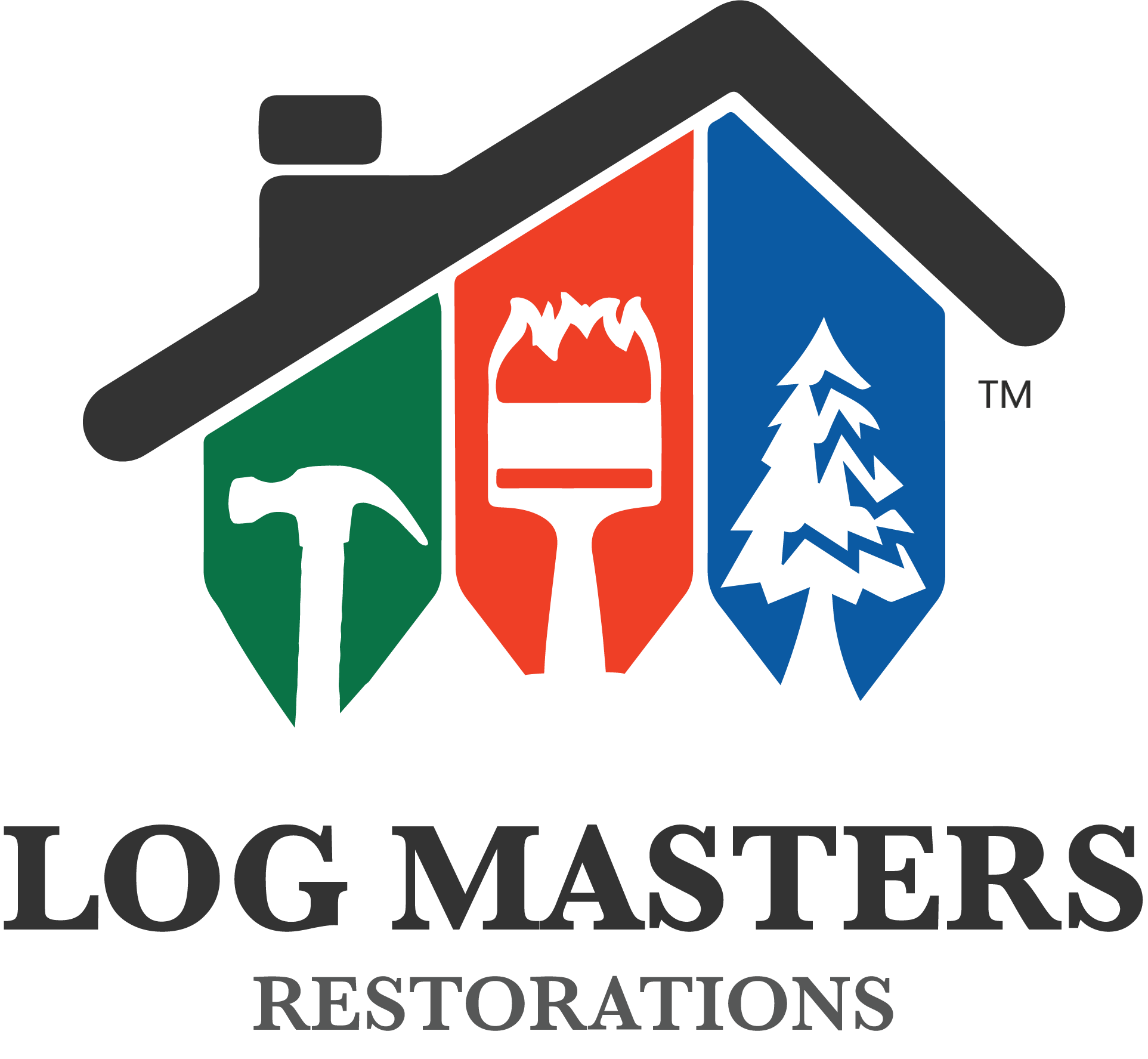Log homes are known for their charm and durability but require ongoing maintenance to stay in top condition. Two of the biggest threats to log homes are log rot and insect infestations. If left unchecked, these issues can weaken the structure of your home, leading to costly repairs.
Understanding what causes log rot, how to identify it, and which insects pose the greatest risk will help you protect your investment. This guide will walk you through everything you need to know about checking for log rot and insect infestations—before they become serious problems.
What is Log Rot?
Log rot occurs when fungi break down the wood fibers, causing logs to soften, crumble, and lose their structural integrity. The primary cause of log rot is excess moisture, which creates the perfect environment for fungal growth. Without proper drainage, sealing, and maintenance, even the highest-quality logs can become vulnerable to decay.
Types of Log Rot
Log rot can take different forms, and all log homeowners need to familiarize themselves with the types of log rot that can occur. Typically, log rot can be classified into two main types: brown and white.
Brown Rot
Also known as “dry rot,” brown rot primarily attacks the cellulose in wood, causing it to shrink and crack into cube-like fragments. Affected logs may appear darker and feel brittle, breaking apart easily. Despite its nickname, brown rot requires moisture to develop but can continue spreading even in drier conditions once established.
White Rot
White rot affects both the cellulose and lignin in wood, leading to a spongy, fibrous texture. Logs with white rot often appear lighter in color, with a whitish or yellowish tint. Unlike brown rot, white rot tends to maintain the wood’s structural shape for longer, but it still weakens the log over time.
What are the Long-Term Impacts of Log Rot?
If left untreated, log rot can have serious consequences:
- Structural Weakening – Rot compromises the strength of logs, leading to sagging walls, unstable support beams, and even structural failure.
- Increased Pest Activity – Damaged wood attracts insects such as termites, carpenter ants, and beetles, further accelerating deterioration.
- Higher Repair Costs – Minor rot issues can often be repaired, but extensive rot may require full log replacement, which is costly and time-consuming.
- Moisture and Mold Problems – Log rot often goes hand-in-hand with mold and mildew, which can impact indoor air quality and create health concerns.
How Can I Check for Log Rot?

Routine inspections are crucial for catching log rot early. Here are the best methods for checking your logs:
- Visual Inspection – Look for discoloration, cracks, peeling finishes, or soft spots. Pay close attention to areas where moisture tends to accumulate.
- Probe Test – Use a screwdriver or skewer to poke the logs. If the wood feels soft, crumbles, or allows the probe to sink in easily, rot may be present.
- Tap Test – Tap the logs with a hammer or screwdriver handle. Solid wood produces a sharp sound, while rotted areas will sound hollow.
- Moisture Meter Test – A moisture meter can detect excessive moisture levels in logs, helping you identify potential problem areas before rot starts.
- Check High-Risk Areas – Log ends, window and door frames, roof overhangs, and foundation areas are particularly vulnerable to rot.
The Probe Test: Our Recommendation
The easiest way to check for log rot is to take the skewer and poke the logs. If the skewer sinks in, you can measure how far it sinks in. Hopefully, the skewer does not sink in anywhere. The best-case scenario is that it only sinks in less than a centimeter or quarter of an inch beyond the point. However, if it sinks in further than that, it is worth getting an accurate estimate.
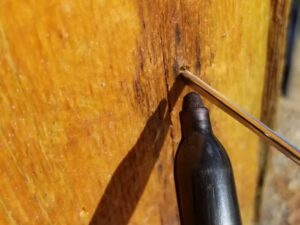
People sometimes use a paint roller frame on a pole to reach high spots. You can also use a screwdriver if you don’t have a skewer.
Preventing Log Rot
Log rot is common in log homes, but proactive treatments can help protect the wood and extend its lifespan. Using borate-based preservatives like Cobra Rods, Tim-bor, and borate treatments effectively prevents fungal decay and deters wood-destroying insects.
- Cobra Rods: These borate-infused rods are inserted into pre-drilled holes in logs, slowly releasing protection against rot and pests.
- Tim-bor: A water-soluble borate powder applied as a surface treatment or injected into the wood to prevent and stop decay.
- Borate Treatments: Applied during restoration or maintenance, borates penetrate deep into the wood, creating long-term protection against moisture-driven rot.
Regular maintenance, proper sealing, and ensuring logs stay dry are also essential to keeping log rot at bay. To learn more about how the plants and things around your home impact log rot, read Log Home Landscaping Wisdom.
What Insects Typically Attack Log Homes?
Wood-destroying insects can cause as much damage as log rot—sometimes even more. Here are the most common culprits:
Carpenter Ants
Carpenter ants don’t eat wood but tunnel through it to create nesting galleries. They often target moist or rotting wood, making log homes susceptible, especially if rot is already present. Signs include wood shavings (frass), rustling sounds inside walls, and large black ants near logs.
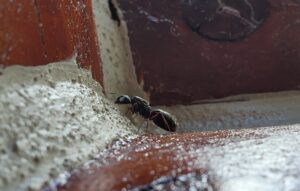
Termites
Termites are among the most destructive pests for log homes. They feed on wood 24/7 and often go undetected until significant damage has occurred. Signs of a termite infestation include mud tubes along logs, discarded wings, and hollow-sounding wood.
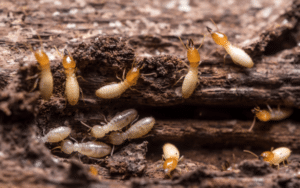
Carpenter Bees
Carpenter bees bore perfectly round holes into logs to lay their eggs. Over time, their activity weakens the wood, and their tunnels can attract woodpeckers, which cause additional damage. Look for small, round entry holes and sawdust piles beneath logs. Carpenter bees are well known for their yellow belly and all-black “shiny hiney,” in contrast to the bumblebee, which is yellow and fuzzy.
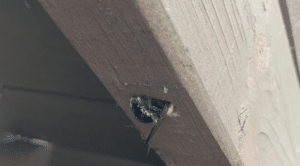
The problem they create is perfect holes for woodpeckers to further destroy and widen in their search for larvae. When a Log Master finds evidence of carpenter bees, we provide “The Total Bee-Fense Kit” from Best Bee Brothers. This company offers many solutions for everyday home infestation problems.
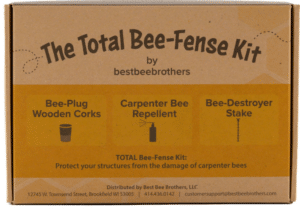
Powder Post Beetles
Powderpost Beetles are destructive wood-boring insects that infest dry, untreated wood. They lay their eggs in cracks or exposed surfaces, and once hatched, the larvae tunnel deep into the wood, breaking it down from the inside. Their activity is identified by tiny exit holes and fine, powdery sawdust (frass) left behind. If left untreated, infestations can persist for years, weakening the structural integrity of log homes.
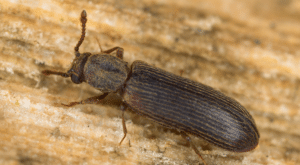
Cluster Flies
While not wood-destroying, cluster flies seek shelter in log homes during cooler months. They also go by the name “Attic Fly” and cluster at windows in an attempt to escape in spring. Their presence indicates gaps or cracks in logs that need sealing. Signs of their presence are often found in their excrement, staining walls, blinds, window seals, floors, and belongings, returning the property year after year to reproduce and grow in numbers. Fitting fly screens over vents, caulking gaps, and using natural repellants like mint, clove, or eucalyptus oils can help minimize their presence and help with the odor they create.
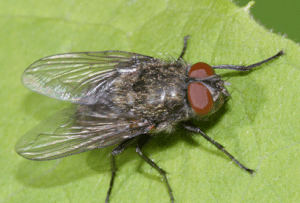
Long-horned Beetles
These beetles lay eggs in dead or decaying wood, and the larvae tunnel through the logs, weakening the structure over time. Their exit holes are larger than those of powder post beetles.
The Old House Borer Beetle (Hylotrupes bajulus) is a long-horned beetle commonly found in log homes. Unlike long-horned beetles that prefer freshly cut or live wood, the Old House Borer targets dry, seasoned softwood, making log homes particularly vulnerable. Their larvae can remain hidden within the wood for years, tunneling and weakening structural integrity before emerging as adults.
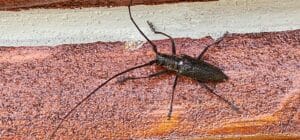
The Old House Borer Beetle is the most common long-horned beetle that attacks log homes.
Side Note: A key distinction between the Old House Borer and Powderpost Beetles is their antennae—long-horned beetles have noticeably long antennae, while Powderpost Beetles have short, stubby ones. Identifying these differences helps determine the best treatment and prevention methods.
What are the Signs of Insect Infestation?
Detecting an insect infestation early can prevent significant damage. Look for these warning signs:
- Small, round exit holes – A sign of wood-boring beetles or carpenter bees.
- Sawdust or frass piles – Indicates active insect activity.
- Hollow-sounding wood – Could signal termites or internal beetle damage.
- Mud tubes on logs – A common sign of subterranean termites.
- Ant trails or swarming insects – May indicate carpenter ants or termites.
- Buzzing or rustling sounds – Could suggest carpenter ants or bees inside logs.
If you notice these signs, immediately consult a log home specialist or pest control expert.
How to Prevent Log Rot and Insect Infestations
Preventative maintenance is key to keeping your log home safe from rot and pests. Here’s how you can protect your home:
Moisture Control
- Maintain a properly sealed and finished exterior to prevent water intrusion.
- Keep gutters clean and functional to direct water away from logs.
- Ensure adequate roof overhangs and drainage to minimize splashback.
Routine Inspections
- Inspect logs seasonally for cracks, discoloration, or soft spots.
- Use a moisture meter to monitor potential problem areas.
Pest Prevention
- Keep firewood and mulch away from your home to deter termites and ants.
- Seal gaps, cracks, and entry points to prevent insects from nesting.
- Treat logs with borate-based preservatives to deter wood-boring pests.
Prompt Repairs
- Address small cracks and rot early before they worsen.
- Replace severely damaged logs to prevent structural weakening.
Don’t Wait Until It’s Too Late: Protect Your Home Today!
Log rot and insect infestations can cause serious damage if left unchecked, but regular maintenance and early detection can help protect your home for years to come. By understanding the warning signs and taking preventative steps, you can enjoy the beauty and durability of your log home without worry.
If you suspect log rot or insect activity, contact Log Masters to assess the situation and recommend the best course of action. Staying proactive will save you time, money, and stress in the long run!
